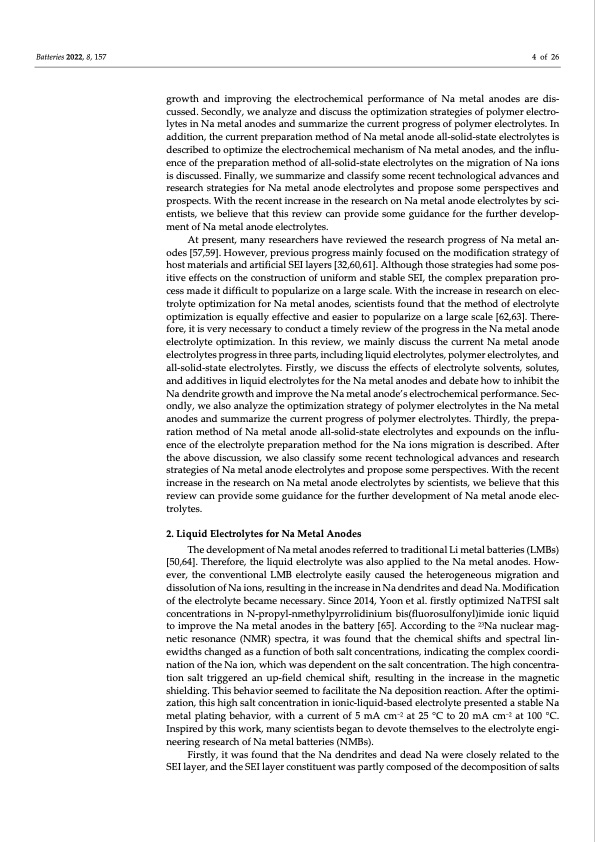
PDF Publication Title:
Text from PDF Page: 004
Batteries 2022, 8, 157 4 of 26 growth and improving the electrochemical performance of Na metal anodes are dis‐ cussed. Secondly, we analyze and discuss the optimization strategies of polymer electro‐ lytes in Na metal anodes and summarize the current progress of polymer electrolytes. In addition, the current preparation method of Na metal anode all‐solid‐state electrolytes is described to optimize the electrochemical mechanism of Na metal anodes, and the influ‐ ence of the preparation method of all‐solid‐state electrolytes on the migration of Na ions is discussed. Finally, we summarize and classify some recent technological advances and research strategies for Na metal anode electrolytes and propose some perspectives and prospects. With the recent increase in the research on Na metal anode electrolytes by sci‐ entists, we believe that this review can provide some guidance for the further develop‐ ment of Na metal anode electrolytes. At present, many researchers have reviewed the research progress of Na metal an‐ odes [57,59]. However, previous progress mainly focused on the modification strategy of host materials and artificial SEI layers [32,60,61]. Although those strategies had some pos‐ itive effects on the construction of uniform and stable SEI, the complex preparation pro‐ cess made it difficult to popularize on a large scale. With the increase in research on elec‐ trolyte optimization for Na metal anodes, scientists found that the method of electrolyte optimization is equally effective and easier to popularize on a large scale [62,63]. There‐ fore, it is very necessary to conduct a timely review of the progress in the Na metal anode electrolyte optimization. In this review, we mainly discuss the current Na metal anode electrolytes progress in three parts, including liquid electrolytes, polymer electrolytes, and all‐solid‐state electrolytes. Firstly, we discuss the effects of electrolyte solvents, solutes, and additives in liquid electrolytes for the Na metal anodes and debate how to inhibit the Na dendrite growth and improve the Na metal anode’s electrochemical performance. Sec‐ ondly, we also analyze the optimization strategy of polymer electrolytes in the Na metal anodes and summarize the current progress of polymer electrolytes. Thirdly, the prepa‐ ration method of Na metal anode all‐solid‐state electrolytes and expounds on the influ‐ ence of the electrolyte preparation method for the Na ions migration is described. After the above discussion, we also classify some recent technological advances and research strategies of Na metal anode electrolytes and propose some perspectives. With the recent increase in the research on Na metal anode electrolytes by scientists, we believe that this review can provide some guidance for the further development of Na metal anode elec‐ trolytes. 2. Liquid Electrolytes for Na Metal Anodes The development of Na metal anodes referred to traditional Li metal batteries (LMBs) [50,64]. Therefore, the liquid electrolyte was also applied to the Na metal anodes. How‐ ever, the conventional LMB electrolyte easily caused the heterogeneous migration and dissolution of Na ions, resulting in the increase in Na dendrites and dead Na. Modification of the electrolyte became necessary. Since 2014, Yoon et al. firstly optimized NaTFSI salt concentrations in N‐propyl‐nmethylpyrrolidinium bis(fluorosulfonyl)imide ionic liquid to improve the Na metal anodes in the battery [65]. According to the 23Na nuclear mag‐ netic resonance (NMR) spectra, it was found that the chemical shifts and spectral lin‐ ewidths changed as a function of both salt concentrations, indicating the complex coordi‐ nation of the Na ion, which was dependent on the salt concentration. The high concentra‐ tion salt triggered an up‐field chemical shift, resulting in the increase in the magnetic shielding. This behavior seemed to facilitate the Na deposition reaction. After the optimi‐ zation, this high salt concentration in ionic‐liquid‐based electrolyte presented a stable Na metal plating behavior, with a current of 5 mA cm−2 at 25 °C to 20 mA cm−2 at 100 °C. Inspired by this work, many scientists began to devote themselves to the electrolyte engi‐ neering research of Na metal batteries (NMBs). Firstly, it was found that the Na dendrites and dead Na were closely related to the SEI layer, and the SEI layer constituent was partly composed of the decomposition of saltsPDF Image | Electrolyte Engineering for Sodium Metal Batteries

PDF Search Title:
Electrolyte Engineering for Sodium Metal BatteriesOriginal File Name Searched:
batteries-08-00157.pdfDIY PDF Search: Google It | Yahoo | Bing
Product and Development Focus for Salgenx
Redox Flow Battery Technology: With the advent of the new USA tax credits for producing and selling batteries ($35/kW) we are focussing on a simple flow battery using shipping containers as the modular electrolyte storage units with tax credits up to $140,000 per system. Our main focus is on the salt battery. This battery can be used for both thermal and electrical storage applications. We call it the Cogeneration Battery or Cogen Battery. One project is converting salt (brine) based water conditioners to simultaneously produce power. In addition, there are many opportunities to extract Lithium from brine (salt lakes, groundwater, and producer water).Salt water or brine are huge sources for lithium. Most of the worlds lithium is acquired from a brine source. It's even in seawater in a low concentration. Brine is also a byproduct of huge powerplants, which can now use that as an electrolyte and a huge flow battery (which allows storage at the source).We welcome any business and equipment inquiries, as well as licensing our flow battery manufacturing.| CONTACT TEL: 608-238-6001 Email: greg@salgenx.com | RSS | AMP |